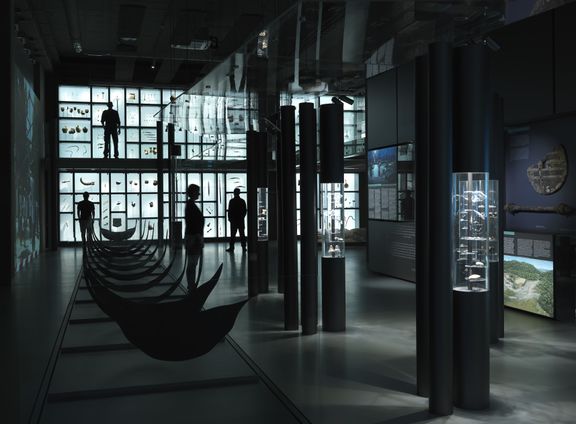Ljubljanica River Exhibition
Background
After the several springs of Ljubljanica come together, this Karst river traverses the Ljubljana Marshes, flows through the city of Ljubljana and finally joins the Sava river. This area has a long history of human settlements and for many centuries the river served as a major traffic lane for the region. As such it is a source of many archaeological finds, with some of them – like the ancient Roman cargo ship from the 1st century AD – still preserved in situ. More than 8000 ancient items have been found here, and the better part of the water flow is declared to be a cultural monument of national significance.
Venue
In 2014 the premises of a former sewing factory (IUV Vrhnika) opened its doors as the new Vrhnika Cultural Centre. While its upper floors host a library and a school, most of the ground floor is dedicated to the museum, which is spread across some 800 square meters.
Permanent exhibition
The major part of the exhibition is dedicated to the Ljubljanica River, presenting the natural and cultural life that evolved around the river as well as the space underwater and in the Karst underground. There are more than 400 original historical objects, many of them originally preserved either in the Ljubljanica or within the Ljubljana Marshes. The oldest original pieces go back to about 7.000 BC. Many of the objects come from the extremely rich archaeological collection of the Potočnik family.
The collection features a Celtic statue of Apolon, a number of weapons, and a replica of the oldest wooden wheel in the world (approx. 3200 BC), with the original displayed by the City Museum of Ljubljana.
One part of the permanent exhibition is dedicated to the history of Vrhnika and its surroundings, tracing it from the Middle Ages until the present day.
Temporary exhibitions and projects
The museum also organises various temporary exhibitions, together with various other institutions setting them up at locations across Vrhnika.
Due to riverbank erosion the dugout canoe – which for centuries stayed preserved in the river – was lifted in 2015. It is currently undergoing a restoration procedure and is due to become a part of the exhibition in the future.
See also
- Vrhnika Cultural Centre
- City Museum of Ljubljana
- Ivan Cankar Institute Vrhnika
- UNESCO World Heritage Sites in Slovenia




